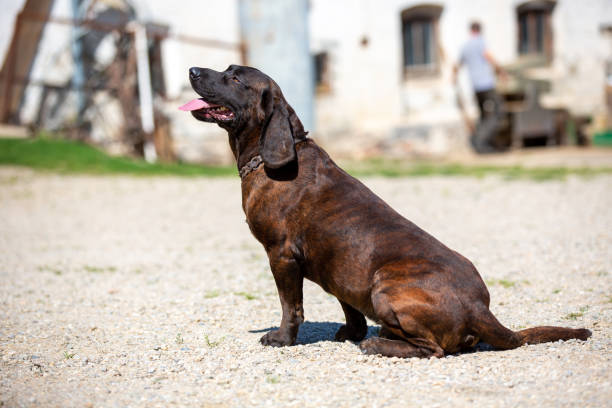Hanvover Hound

Breed History:
The Hanover Hound, or Hannoverscher Schweißhund, is a German scent hound with roots tracing back to medieval hunting traditions. It was developed from ancient Celtic scent hounds and later refined in the Kingdom of Hanover during the 17th and 18th centuries. The breed’s primary purpose was “Schweißarbeit”—blood tracking of wounded game like wild boar and deer.
Highly prized for its cold nose, precision, and persistence, the Hanover Hound was a crucial companion for foresters and professional gamekeepers, particularly in rugged terrain. Today, it remains a working specialist, used across Europe in tracking wounded animals, and is recognised by the FCI.
|
Gender |
Height |
Weight |
|
Male |
50-55 cm |
30-40 kg |
|
Female |
48-53 cm |
25-35 kg |
Size: Medium to Large
Life Expectancy: 10–14 years

Breed Appearance:
The Hanover Hound is powerfully built, with a broad head, long drooping ears, and a slightly wrinkled forehead, giving it a serious, focused look. Its body is muscular and long, built for endurance rather than speed.
The coat is short, dense, and harsh, typically reddish fawn to mahogany in colour, often with darker shading or a black mask. The tail is long and tapers toward the tip, held low when relaxed.
Breed Type – Tracking Scent Hound:
Bred specifically for blood trailing wounded game, the Hanover Hound is methodical, determined, and known for its extraordinary scenting ability. It works calmly and slowly, maintaining contact with even faint scent trails.
Though serious in the field, it is gentle, loyal, and reserved at home, especially when bonded to a single handler. It is not overly social but deeply connected to its human pack.

Training:
The breed is intelligent but independent, requiring firm, patient, and consistent training. It responds well to positive reinforcement, especially when given tasks that simulate tracking or scent work.
Early socialisation helps it become more adaptable, but it remains primarily a specialist working dog rather than a casual pet.
Health & Care:
The Hanover Hound is a hardy breed but may be prone to:
-
Hip dysplasia
-
Elbow dysplasia
-
Ear infections (due to floppy ears)
-
Bloat (gastric torsion)
Regular vet care, clean ears, and a high-protein, joint-supporting diet are important. Avoid overfeeding or long, strenuous exercise in young dogs.

Living Conditions:
This breed is not suitable for apartment living. It thrives in rural or woodland environments with secure fencing and room to roam. The Hanover Hound needs mental engagement and physical work, ideally in a hunting or tracking role.
While calm indoors, it is not ideal for homes with lots of visitors or chaotic energy. A quiet, consistent environment suits it best.
Exercise:
The Hanover Hound requires daily physical and mental stimulation. Ideal activities include:
-
Long, purposeful walks
-
Tracking or scent work
-
Outdoor exploration on leash or in safe areas
-
Scent puzzles or field exercises
Without stimulation, it may become bored or destructive.
Grooming:
Minimal grooming requirements:
-
Weekly brushing to manage shedding
-
Regular ear cleaning to prevent infections
-
Routine nail trimming and dental care
-
Bathing only occasionally
The coat is weather-resistant and easy to care for.

Advantages:
-
Exceptional scent-tracking and trailing abilities
-
Loyal, calm, and deeply bonded to its handler
-
Low grooming needs
-
Hardy and resilient in outdoor conditions
-
Excellent for hunters or search-and-rescue use
-
Rich heritage and working pedigree
Disadvantages:
-
Not suited to city or apartment life
-
Independent and strong-willed—needs experienced handling
-
Aloof with strangers, not ideal as a social companion
-
Needs regular work or it may become bored
-
Strong scent drive—can wander if off-leash
-
Ear care and joint monitoring are essential

